
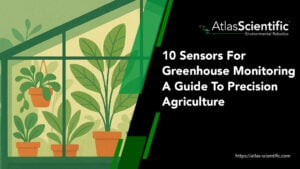
10 Sensors For Greenhouse Monitoring – A Guide To Precision Agriculture
Greenhouse monitoring is the backbone of precision agriculture, and it starts with the right sensors. The 10 most essential sensors to optimize crop health and
# Type at least 1 character to search # Hit enter to search or ESC to close

No products in the cart.

No products in the cart.
Product Categories
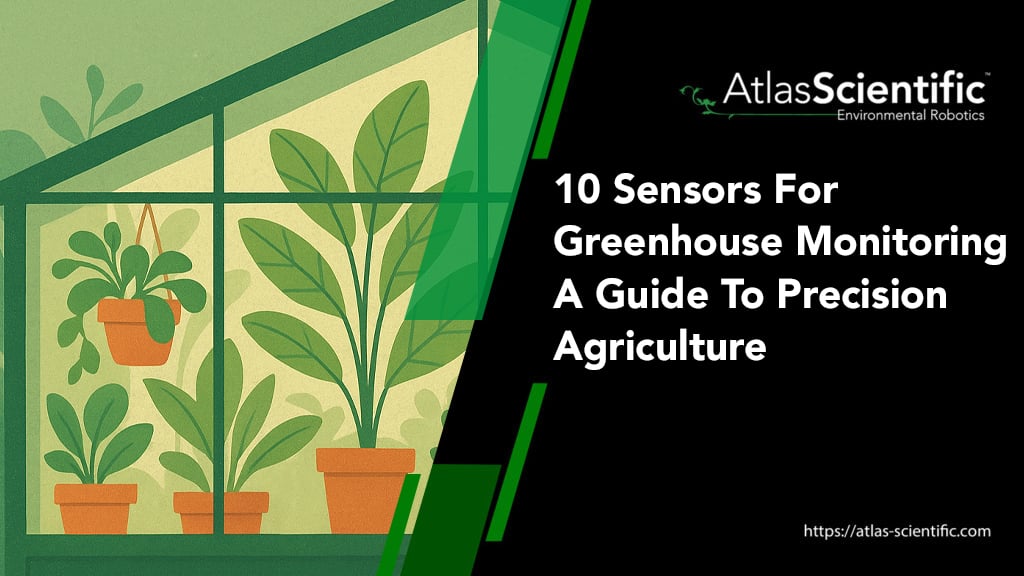
Greenhouse monitoring is the backbone of precision agriculture, and it starts with the right sensors. The 10 most essential sensors to optimize crop health and resource efficiency in greenhouse environments are temperature, humidity, CO2, pH, EC, soil moisture, light, wind speed, pressure, and leaf wetness, each playing a vital role in precise environmental control and automation.
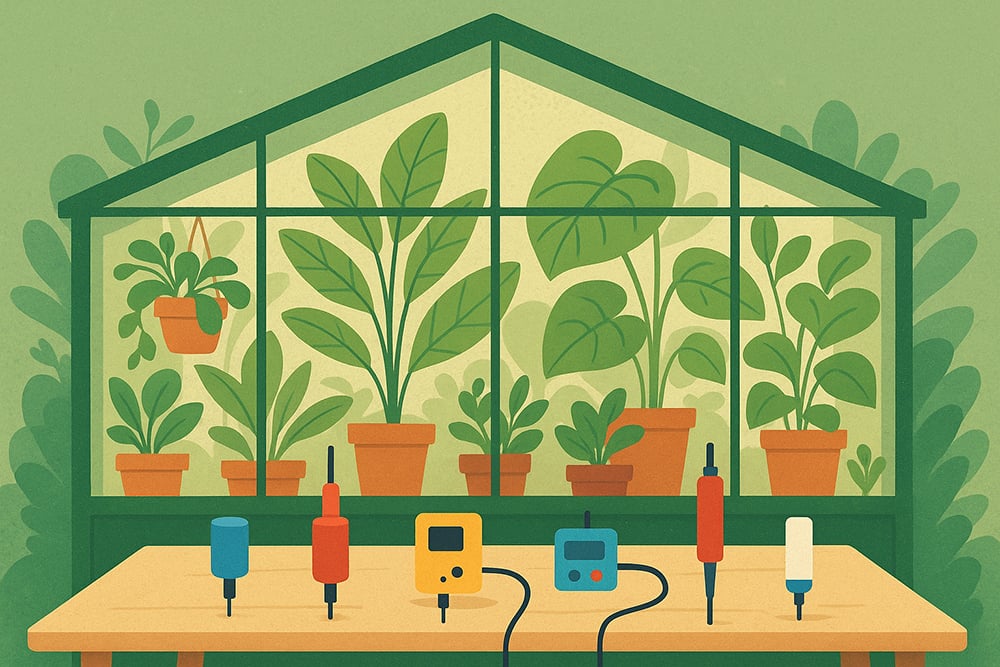
Modern greenhouse operations rely on accurate environmental control to minimize resource waste, maximize crop yields, and ensure consistent crop quality. Over the years, smart greenhouse technology has revolutionized the agriculture industry by utilizing advanced sensors and systems that monitor, analyze, and automatically adjust growing conditions in real-time.
A greenhouse monitoring system uses multiple sensors to create optimal growing conditions. While smaller greenhouse operations may use 3 or 4 sensors, commercial agriculture usually deploys 8 to 12 different sensors to achieve maximum automation and precision.
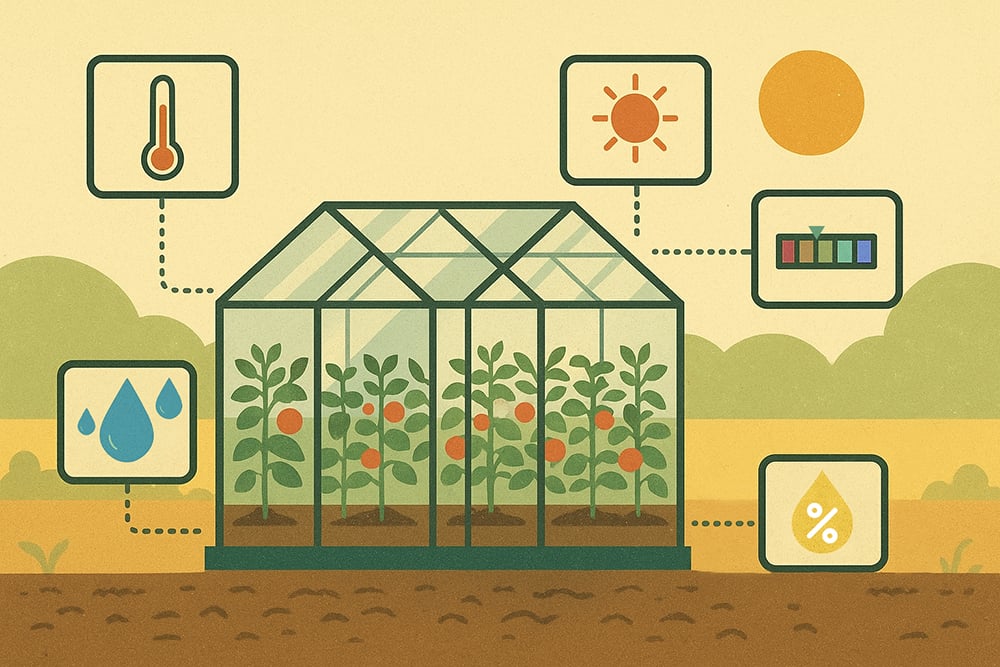
It is estimated that by 2025, the global smart greenhouse market (hydroponics and non-hydroponics) will reach USD$2.1 billion. At the heart of these systems are sensors that provide data for year-round crop production, resource efficiency, and intelligent decision-making.
In this article, we will look at everything from small-scale hobby greenhouse monitoring to commercial growing systems and what sensors we recommend to optimize your growing skills and, most importantly, be successful.
Temperature and humidity sensors are two of the most important sensors for greenhouse monitoring systems. Temperature and humidity directly affect transpiration rates, plant respiration, nutrient uptake, and metabolic processes.
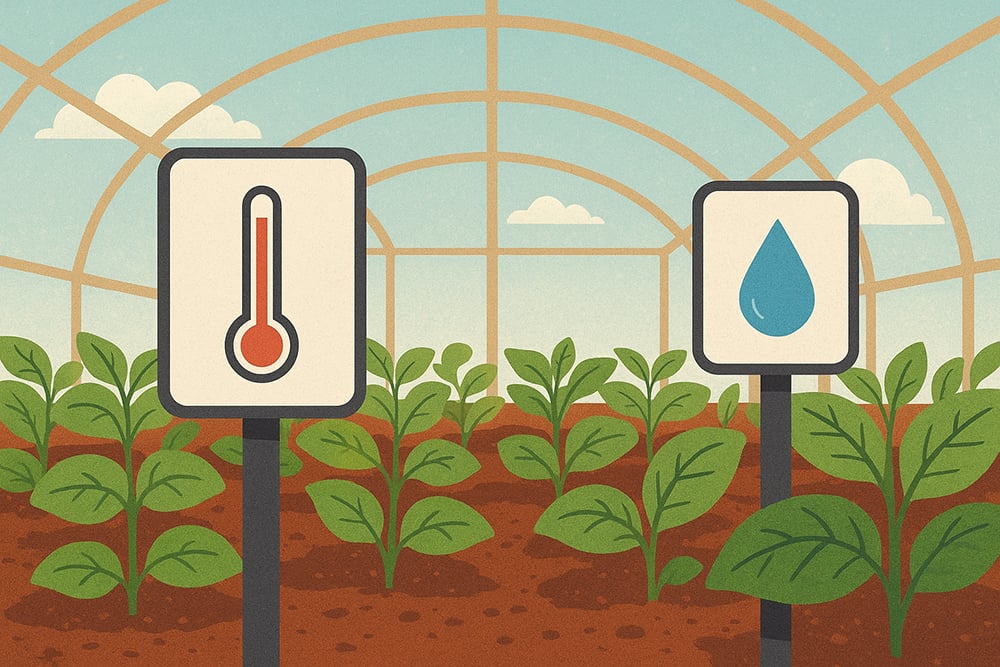
The temperature range depends on what crop you’re growing in your greenhouse. Here are a few popular examples:
At Atlas Scientific, our advanced humidity and temperature sensors offer superior accuracy and stability compared to analog alternatives. We have a range of temperature sensors, from the Standard PT-100 Temperature Probe (made from stainless steel, making it food safe and highly resistant to corrosion) to the Spike Tip PT-100 Temperature Probe, which has a long, thin body, making it ideal for impaling into soil (the Earth) or food.
The Atlas Scientific humidity sensors are engineered for diverse applications, including environmental monitoring and industrial processes. We have two different humidity designs:
Both these humidity sensors offer accuracy within +/- 2% of reading from 5-95% RH. High humidity can promote fungal diseases, while low levels increase plant stress and can reduce photosynthetic efficiency. This is why smart humidity control systems are critical in greenhouse monitoring.
Carbon dioxide directly impacts photosynthetic rates and crop yields in greenhouse operations. For example, ambient atmospheric CO2 levels around 400 ppm are often insufficient for optimal plant growth, particularly in indoor greenhouse environments.
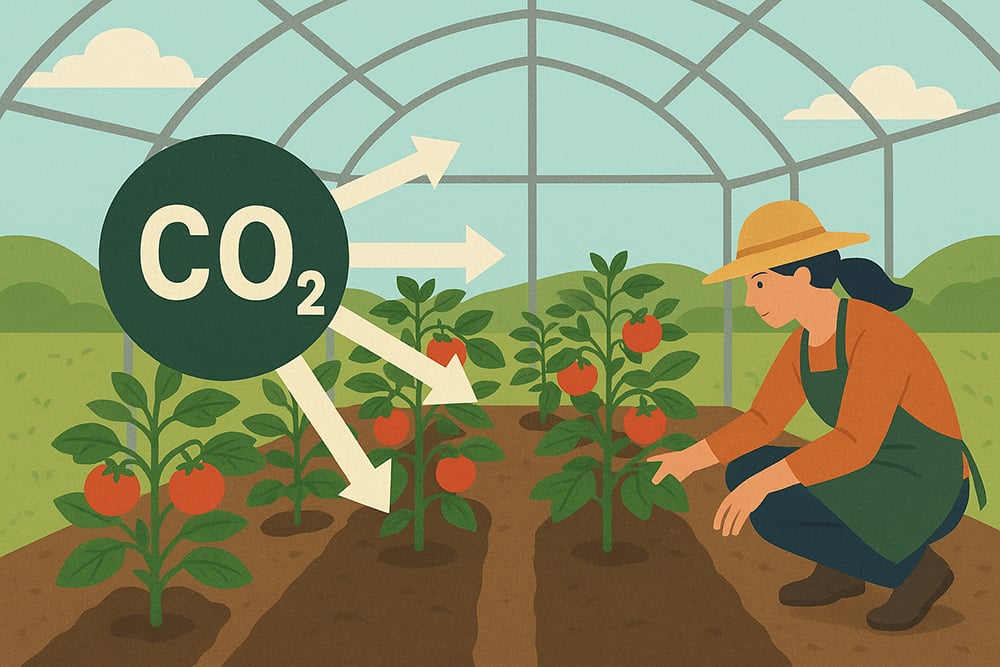
NDIR vs. Electrochemical CO2 Sensors:
The Atlas Scientific EZO-CO2 sensor is a compact Non-Dispersive Infrared (NDIR) sensor that delivers straightforward CO2 measurements in ppm. Featuring built-in temperature and humidity compensation, this sensor makes sophisticated environmental monitoring simple and effective for greenhouse applications.
CO2 enrichment can increase yields up to 40%, but effectiveness depends on adequate light levels and temperature control. During peak photosynthetic periods (midday with high light), CO2 levels can drop below 200ppm in sealed greenhouses, severely limiting growth.
Strategic CO2 sensor placement is crucial. We recommend installing sensors at the canopy level where CO2 concentrations fluctuate most dramatically. Avoid locations near heating systems, vents, or CO2 injection points that could provide false readings.
Electrical conductivity measurement provides insight into total dissolved salts and nutrient concentrations in growing media. EC sensors are essential for both soil and hydroponic systems.
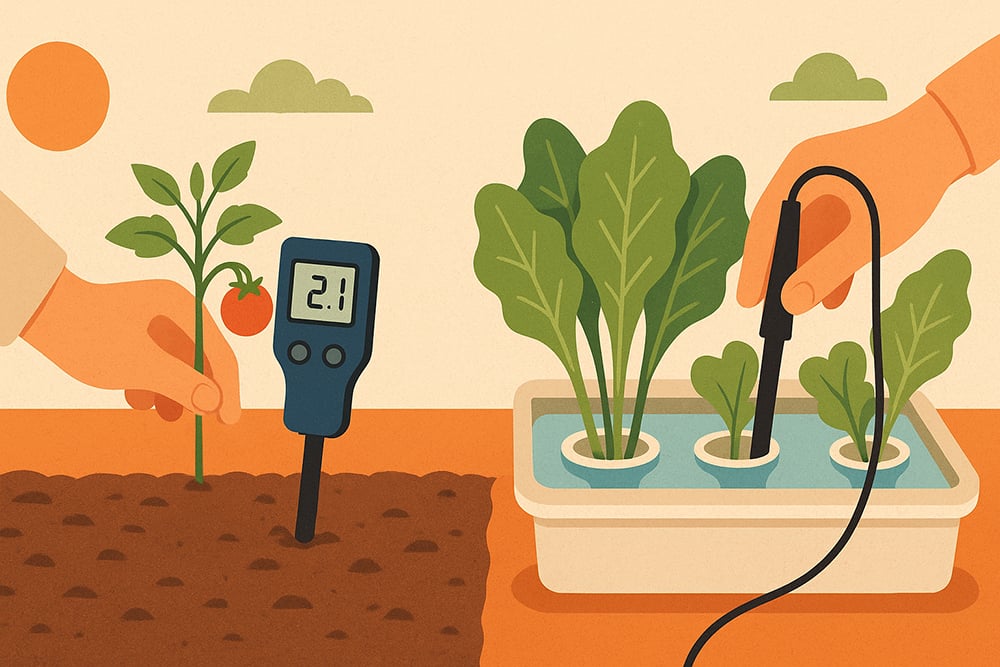
The Atlas Scientific line of conductivity probes has been designed to provide stable and precise readings free of fringe effect over a broad conductivity range. Because conductivity probes don’t have any electrolyte that gets depleted, they only need to be calibrated during installation.
High EC levels (>4.0 mS/cm) can cause salt stress and reduce water uptake, while low levels (<0.5 mS/cm) indicate insufficient nutrients. Professional systems maintain EC within ±0.2 mS/cm of target values through automated nutrient dosing. Combined EC and pH monitoring enables precise nutrient management, reducing fertilizer waste while optimizing plant nutrition.
Soil pH directly affects nutrient availability and uptake efficiency. Most greenhouse crops perform optimally in slightly acidic to neutral conditions (pH 6.0-7.0), but specific requirements vary depending on the type of crop.
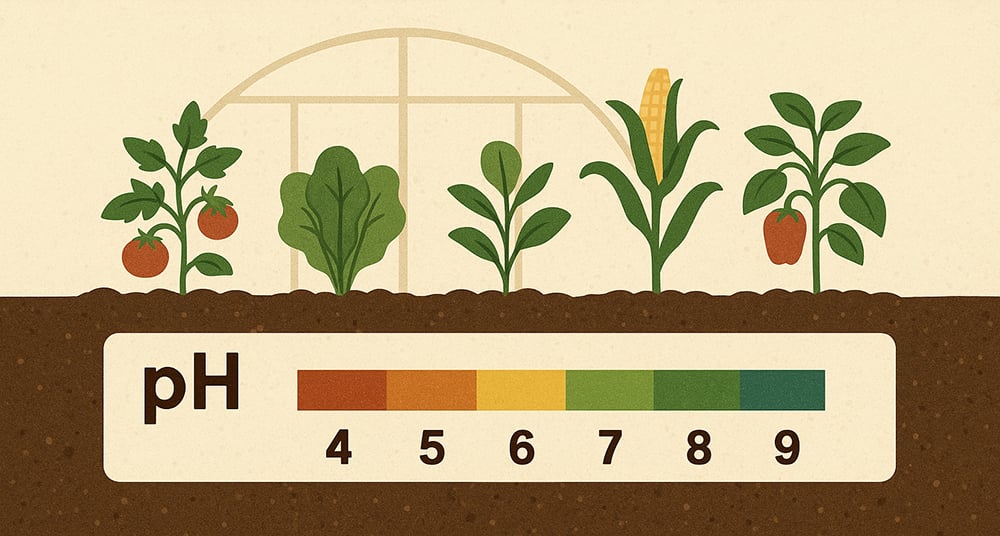
Modern digital pH sensors offer several advantages over traditional glass electrodes in greenhouse applications:
Continuous pH monitoring enables proactive nutrient management rather than reactive correction. Dosing pump systems can automatically dose pH adjustment solutions to maintain optimal ranges within ±0.2 pH units.
Light measurement in greenhouses requires specialized sensors capable of detecting both photosynthetically active radiation (PAR) and analyzing a wide spectrum of colors. Most plants thrive under red light and promote flowering and fruiting, while other plants require blue light for boosting leaf growth. We recommend a full-spectrum of light that gives you all the light colours your crops need.
The Atlas Scientific EZO-RGB-P sensor features a robust, weather-resistant housing available in either photosensitive resin or stainless steel. With flexible mounting capabilities, built-in illuminator LEDs, and a user-friendly data protocol, this device makes advanced color detection technology both practical and accessible.
Soil moisture sensors prevent both under-watering and over-watering, two of the most common causes of crop failure in greenhouse operations. Modern sensors use various technologies, each with specific advantages.
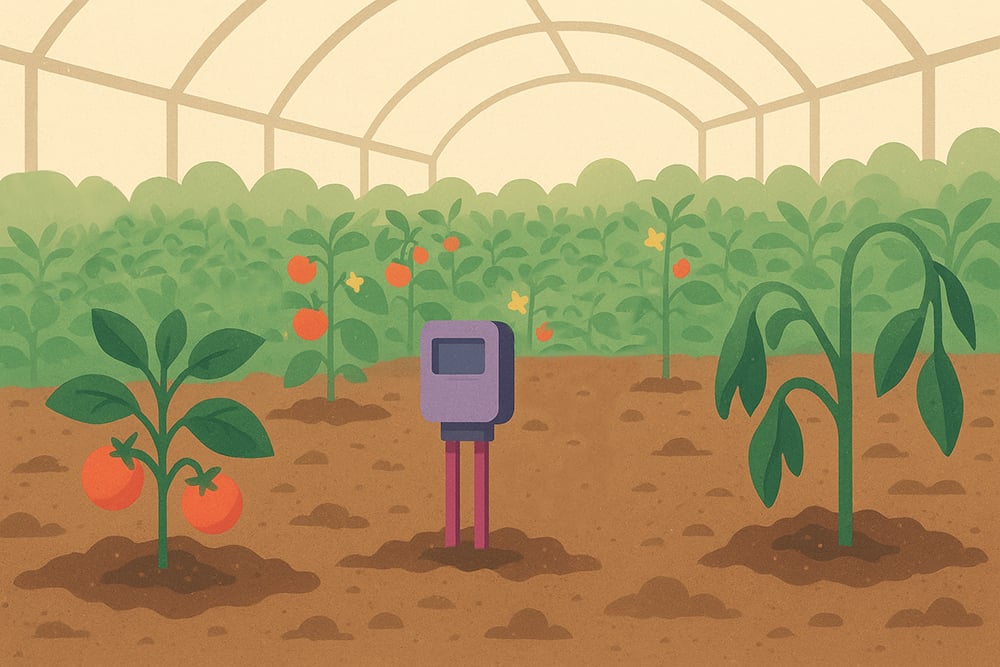
Professional growers deploy multiple sensors at different depths (5cm, 15cm, 30cm) to monitor root zone moisture distribution. This approach prevents surface irrigation that wastes water while leaving deeper roots stressed.
Automated irrigation systems using soil moisture data can reduce water consumption by 25-50% while improving crop uniformity. Set irrigation triggers at 70-80% of field capacity to maintain optimal moisture without waterlogging.
Rain sensors prevent water damage and optimize irrigation scheduling by detecting precipitation events. Modern sensors distinguish between light mist and heavy rainfall for precise response control.
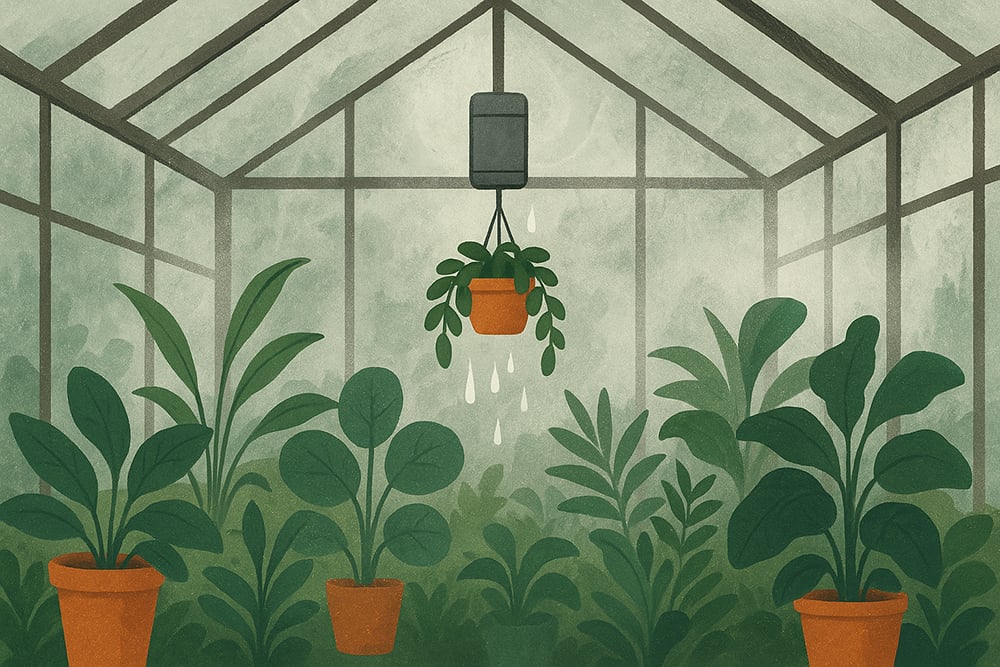
Sensor Types:
Automated Responses:
Professional systems integrate precipitation data with soil moisture readings to optimize irrigation scheduling, potentially reducing water usage during rainy periods.
Barometric pressure monitoring enables predictive weather management and optimizes natural ventilation systems. Pressure changes often precede weather events by 6-24 hours.
Applications:
Modern pressure sensors offer accuracy within ±0.1 hPa and can detect pressure changes as small as 0.01 hPa. This sensitivity enables early warning systems for severe weather events. The Atlas Scientific EZO-PRS digital pressure sensor delivers precise measurements at an affordable price point. This versatile sensor monitors pressure levels in liquids, gases, and oils across a 0-74 psi range.
External weather monitoring protects greenhouse structures and optimizes ventilation systems. Wind sensors prevent damage during severe weather while optimizing natural ventilation strategies.
Critical Wind Speed Thresholds:
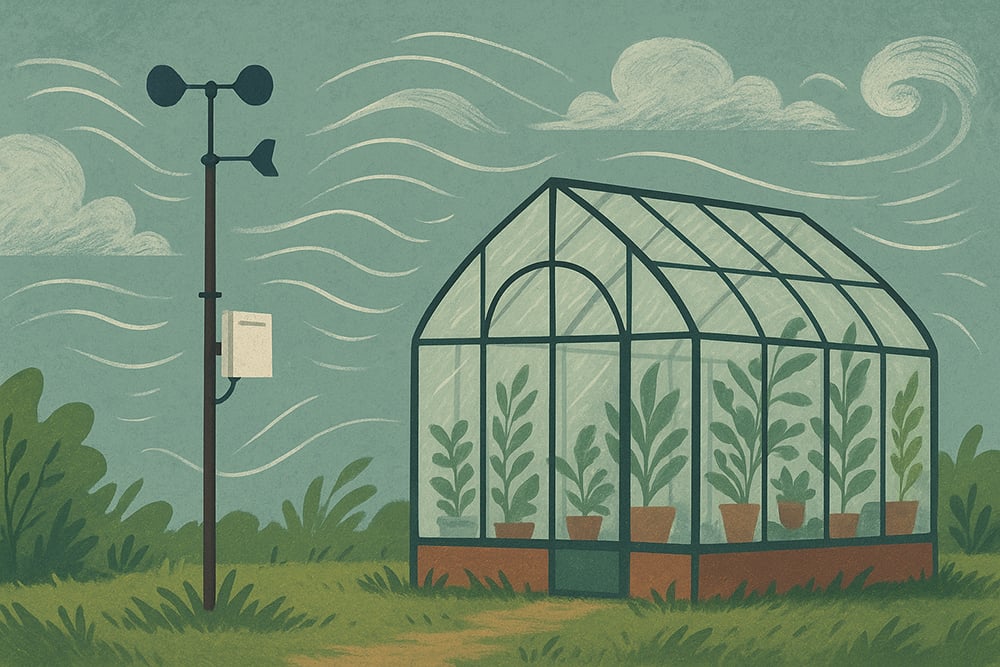
Sensor Technologies:
Modern wind sensors integrate with greenhouse automation systems to automatically close vents during high wind conditions, ptimize natural ventilation based on wind direction, activate structural protection systems, and adjust CO2 injection rates based on air exchange.
Proper sensor placement is critical. We recommend installing wind speed sensors 10-15 feet above greenhouse height to avoid structural interference while maintaining relevance to ground-level conditions.
Leaf wetness sensors detect moisture accumulation on plant surfaces, providing critical data for disease prevention. Many plant pathogens require specific moisture conditions for spore germination and infection.
Disease-Moisture Relationships:
Integration with climate control activates dehumidification systems when leaf wetness is detected, can adjust heating schedules to prevent condensation, modify ventilation patterns to improve air circulation, and trigger alerting systems for immediate management response.
Proper sensor placement is vital for obtaining accurate environmental data that truly represents your growing conditions. Install sensors at plant canopy level to capture the most relevant microclimate data, as this is where your plants experience temperature, humidity, and light conditions. The canopy level provides readings that directly correlate with plant stress and growth patterns, making it far more valuable than ambient air measurements.
For larger greenhouse operations, deploy multiple sensors throughout the facility to account for environmental variations across different zones. We suggest installing one sensor per 1,000-2,000 square feet, though this may need adjustment based on your greenhouse layout and ventilation patterns. Avoid placing sensors near heating equipment, cooling fans, or air circulation systems, as these create localized microclimates that don’t represent the broader growing environment.
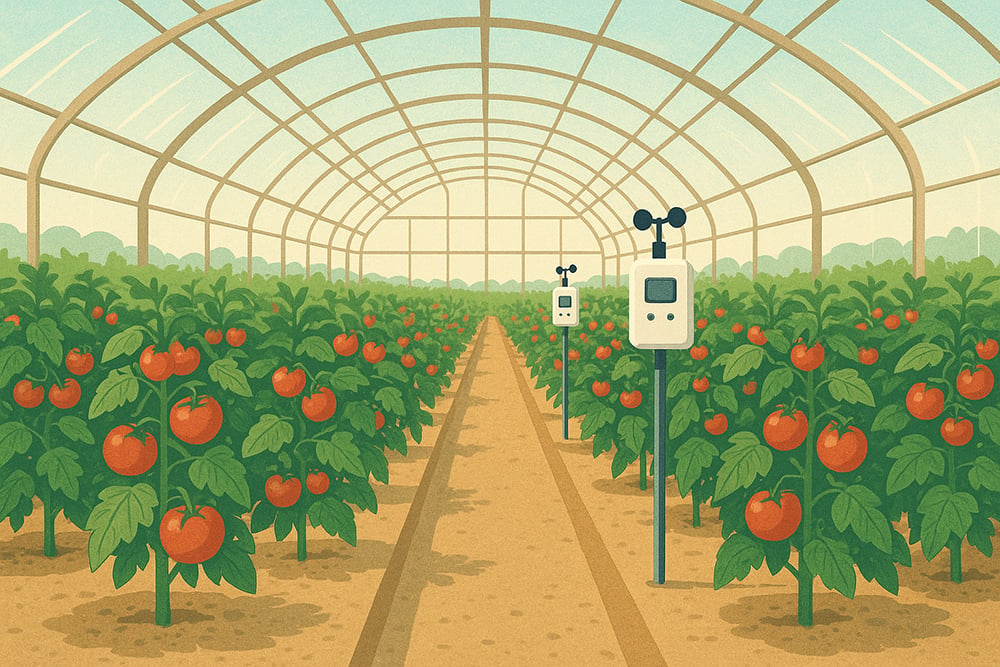
When using wireless sensors, ensure strong signal connectivity throughout your entire facility before finalizing placement locations. Poor signal strength can lead to data gaps and unreliable monitoring, undermining the effectiveness of your entire sensor network.
Modern greenhouse monitoring platforms have revolutionized how growers access and utilize environmental data. These sophisticated systems integrate all sensor data into unified dashboards that provide comprehensive real-time monitoring, historical trending analysis, and predictive analytics capabilities. This integration allows you to identify patterns, optimize growing conditions, and make data-driven decisions that improve crop yields and resource efficiency.
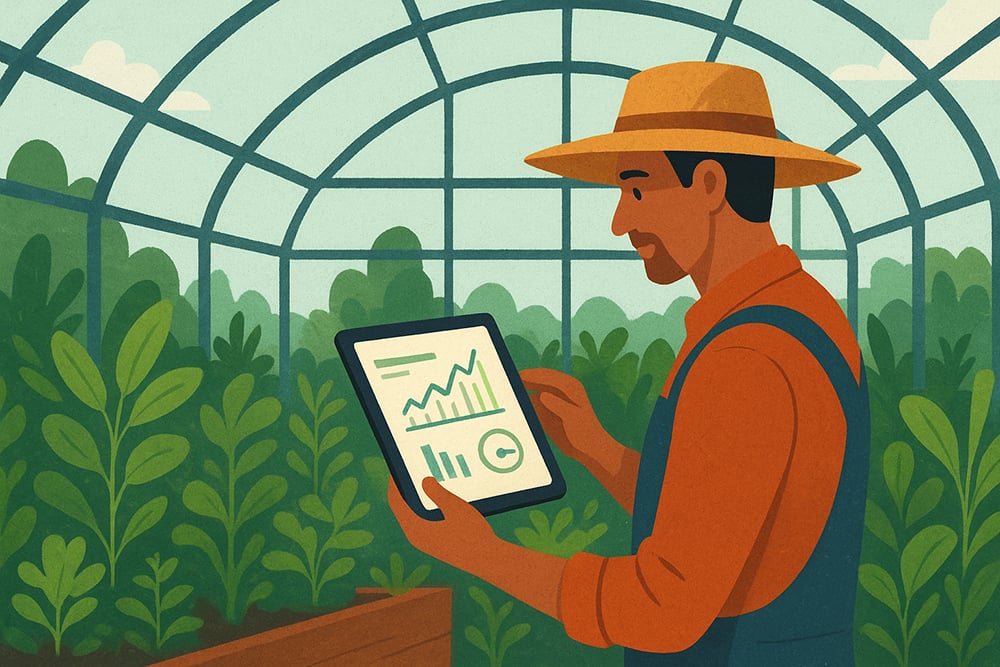
When selecting a greenhouse management platform, prioritize systems that offer cloud-based data storage with API access for seamless integration with other software tools. Mobile compatibility is essential for remote monitoring, allowing you to check conditions and receive updates whether you’re at home, traveling, or working in different areas of your operation. Automated alerting systems should notify you via SMS or email when parameters exceed preset thresholds, enabling rapid response to potential problems.
Additionally, ensure your chosen platform can integrate with existing automation equipment such as ventilation controllers, irrigation systems, and climate control devices. This integration creates a cohesive ecosystem where sensor data directly influences automated responses, reducing manual intervention and maintaining optimal growing conditions around the clock.
Consistent sensor maintenance and calibration are fundamental to reliable data collection and system performance. Without proper maintenance, even the most sophisticated sensors can provide inaccurate readings that lead to poor growing decisions and reduced crop quality.
pH and electrical conductivity (EC) sensors require monthly calibration using certified calibration solutions and conductivity standards. These sensors directly contact nutrient solutions and are prone to drift over time, making regular calibration essential for accurate nutrient management. Clean optical sensors, including light meters and color sensors, weekly to prevent dust, condensation, or residue from interfering with light measurements.
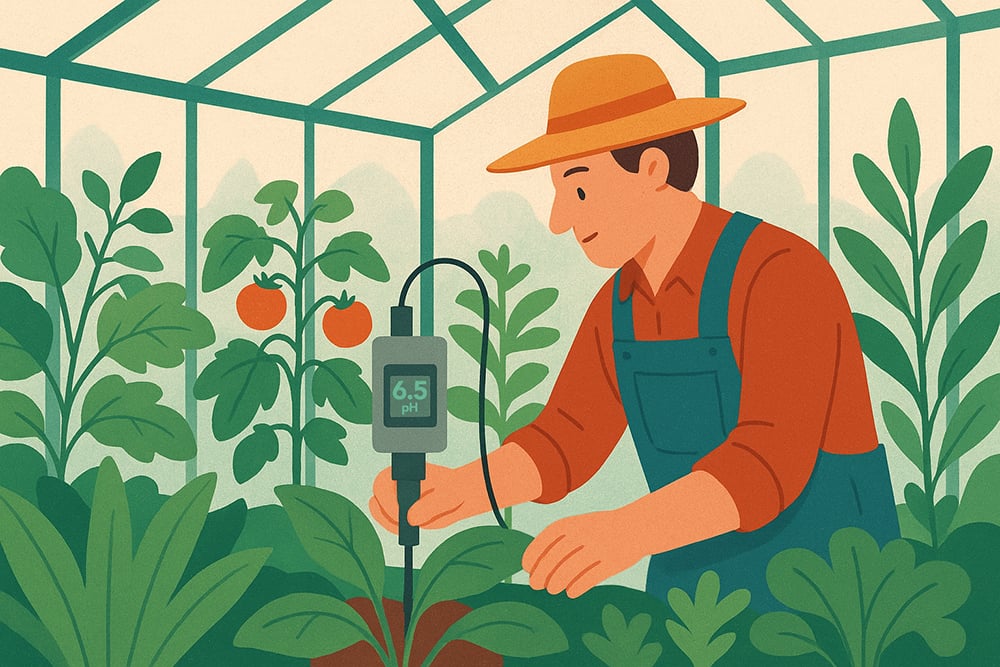
Battery-powered sensors should have their batteries replaced annually, or consider upgrading to wired power systems where feasible to eliminate battery-related failures. Temperature sensors, while generally stable, should be verified annually against certified reference thermometers to ensure continued accuracy. This verification process helps identify sensors that may have drifted beyond acceptable tolerances and need replacement.
Establish a maintenance schedule that includes sensor inspection, cleaning, and calibration tasks. Document all maintenance activities and calibration results to track sensor performance over time and identify units that may require more frequent attention or replacement. This proactive approach minimizes data interruptions and ensures your environmental monitoring system continues to provide the reliable information needed for successful greenhouse operations.
Smart greenhouse monitoring depends on the sensor networks used for intelligent crop management. While the initial investment in high-quality sensors may seem daunting, the long-term benefits in terms of reduced labor requirements, increased yields, and resource efficiency are what make smart sensors essential for greenhouse operations.
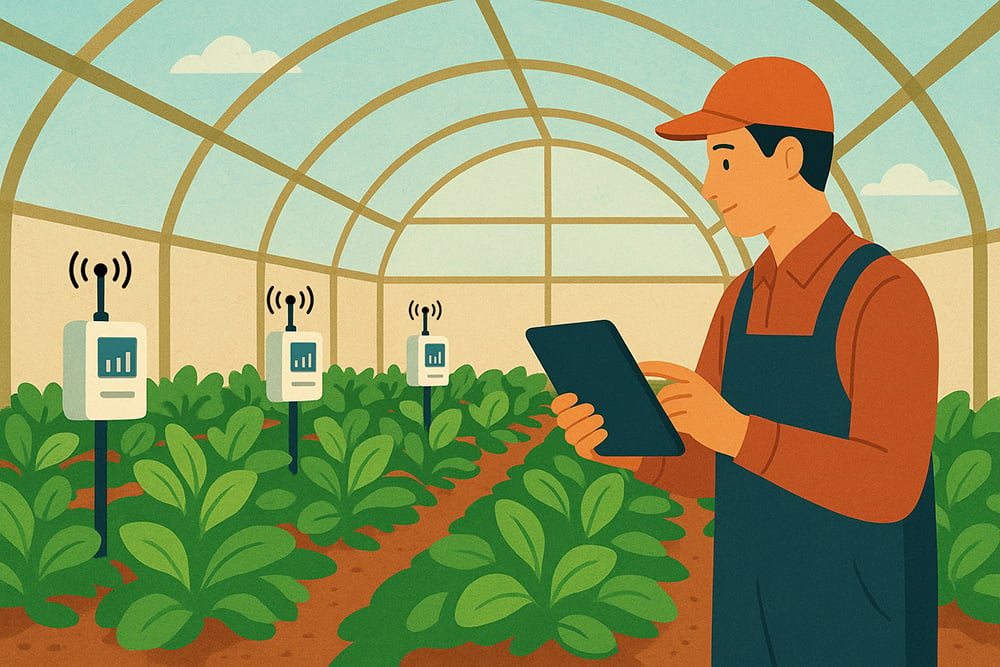
If you would like more expert advice on selecting and using greenhouse sensor systems for your particular crops and facility needs, contact the world-class team at Atlas Scientific.

Greenhouse monitoring is the backbone of precision agriculture, and it starts with the right sensors. The 10 most essential sensors to optimize crop health and
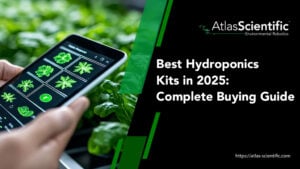
Hydroponics has revolutionized the way people grow food, offering soil-free methods that deliver nutrients directly to plant roots in water-based systems. But success in hydroponics